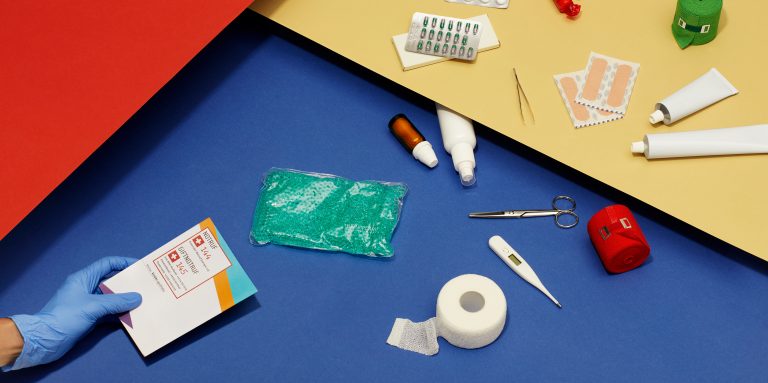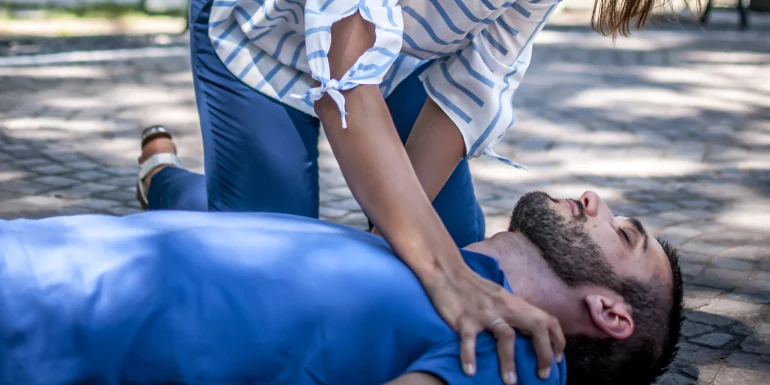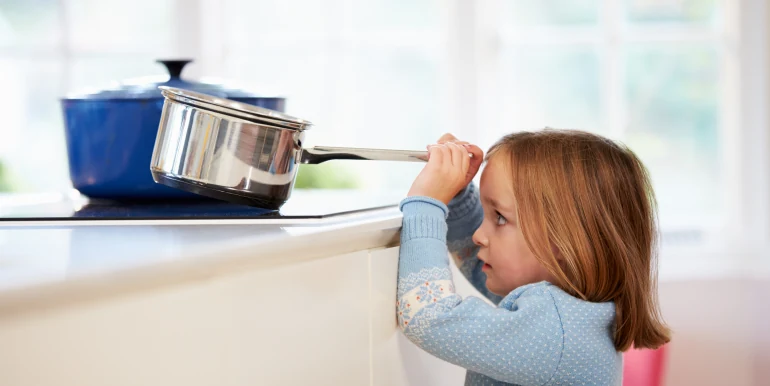
Medicine cabinet: essential items in an emergency
Whether it’s a burn from cooking, a cut from a carpet knife or an unstable ladder: accidents can happen at home. That’s why a well-organised medicine cabinet is essential.
If we were to conduct a nation-wide survey, most Swiss people would presumably say that they have a medicine cabinet at home. So far, so good! And most of them would have similar medicine cabinets, which is usually a cupboard in the bathroom or kitchen with a colourful mix of tablets, half-empty tubes and some kind of bottle without a label. Not so good. If there was a quality seal for medicine cabinets, most of them wouldn’t get it.
What’s it like in your house? Find out what makes up the perfect first aid kit.
Checklist for your medicine cabinet
- Thermometer
- Pain medication
- Fever-reducing medication
- Medication to stop vomiting
- Diarrhoea medication
- Glucose: ideal as an emergency measure against drowsiness and circulatory problems
- Nasal spray (for colds and runny noses)
- Materials for dressings
- Plasters in various sizes
- Compresses
- Gauze dressings
- Scissors (for cutting dressings)
- Antiseptic (Important: always disinfect cuts and abrasions first! Depending on the depth of the cut, you should stop the bleeding before disinfecting.)
- Disposable gloves
- Cooling pads (Tip: always keep a cooling pad ready in the fridge. This is important for bruises and strains.)
- Tweezers for splinters and ticks (Important: to remove ticks, we suggest using pointed tweezers, or special tweezers designed for removing ticks. Alternative: tick card, available at pharmacies.)
- Magnifying glass: especially helpful for small splinters
- Torch: helpful in poor lighting conditions
Bathrooms and kitchens are the preferred places for a medicine cabinet. But that’s not ideal. In both places, the temperature can fluctuate greatly. This isn’t the best environment for medication, and it can make the medication less effective. That’s why it’s best to put your medicine cabinet in a dark, cool and dry place such as the bedroom or a store room.
Do you have small children living in your household? Then place your family pharmacy in a place out of the reach of your offspring. Ideally in a medicine cabinet with a lock. Speaking of children: inform your babysitter and any other family members or friends who look after your little ones about the location of your medicine cabinet.
Quality before quantity – this also applies to your medicine cabinet. An unorganised heap of medication doesn’t leave much space, and means you won’t know what’s what. In an emergency, you have to know where things are as it’s too easy to grab the wrong medication or bottle in the heat of the moment.
No matter if you’re a child or an adult: the medicine cabinet is for everyone who lives in the house. Which is why any prescription medication that is only meant for certain people in the household, does not belong in the medicine cabinet. Furthermore, medicinal products for pets shouldn’t be kept in it, either.
You should sort through your medicine cabinet once a year. Check the expiry dates and condition of the medicinal products. Throw away medication that has a strange smell or taste, is crumbly, has dried up or has changed colour. Not sure if the medication is still good? Then ask at your nearest pharmacy.
If you have found expired medication in your medicine cabinet, there are many ways to dispose of it. But don’t throw it down the toilet. Most expired medicines can be given in at the pharmacy. Medicinal products that are plant-based can be thrown away with the usual household waste.
A list with all the important emergency telephone numbers is very helpful and can save a lot of time. In an emergency, it’s easy to forget even the most memorable telephone numbers. Additionally, put some first aid instructions next to the list of telephone numbers.
What was the medication prescribed for? How long can you use it for at a time? What’s the dose? Write the answers to questions such as these directly on the medication packaging, using a pen and a sticker. It’s best to do it as soon as the medication has been prescribed. This reduces uncertainty for you and others in your household when it’s used at a later point in time.



Newsletter
Find out more about current health issues every month and get all the information you need about our attractive offers from all Helsana Group companies * delivered by e-mail to read whenever it suits you. Our newsletter is free of charge and you can sign up here:
We did not receive your information. Please try again later.
* The Helsana Group comprises Helsana Insurance Company Ltd, Helsana Supplementary Insurances Ltd and Helsana Accidents Ltd.